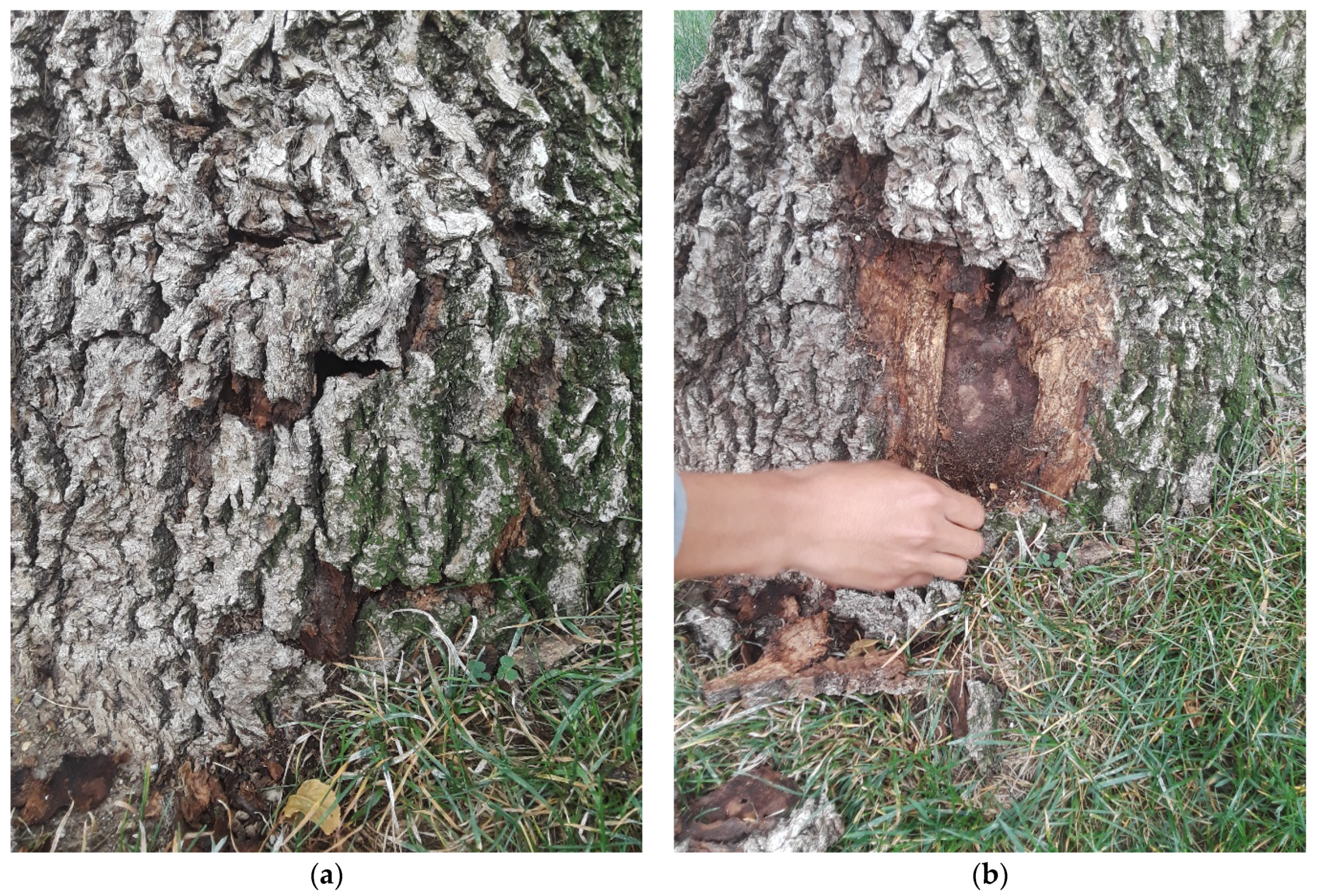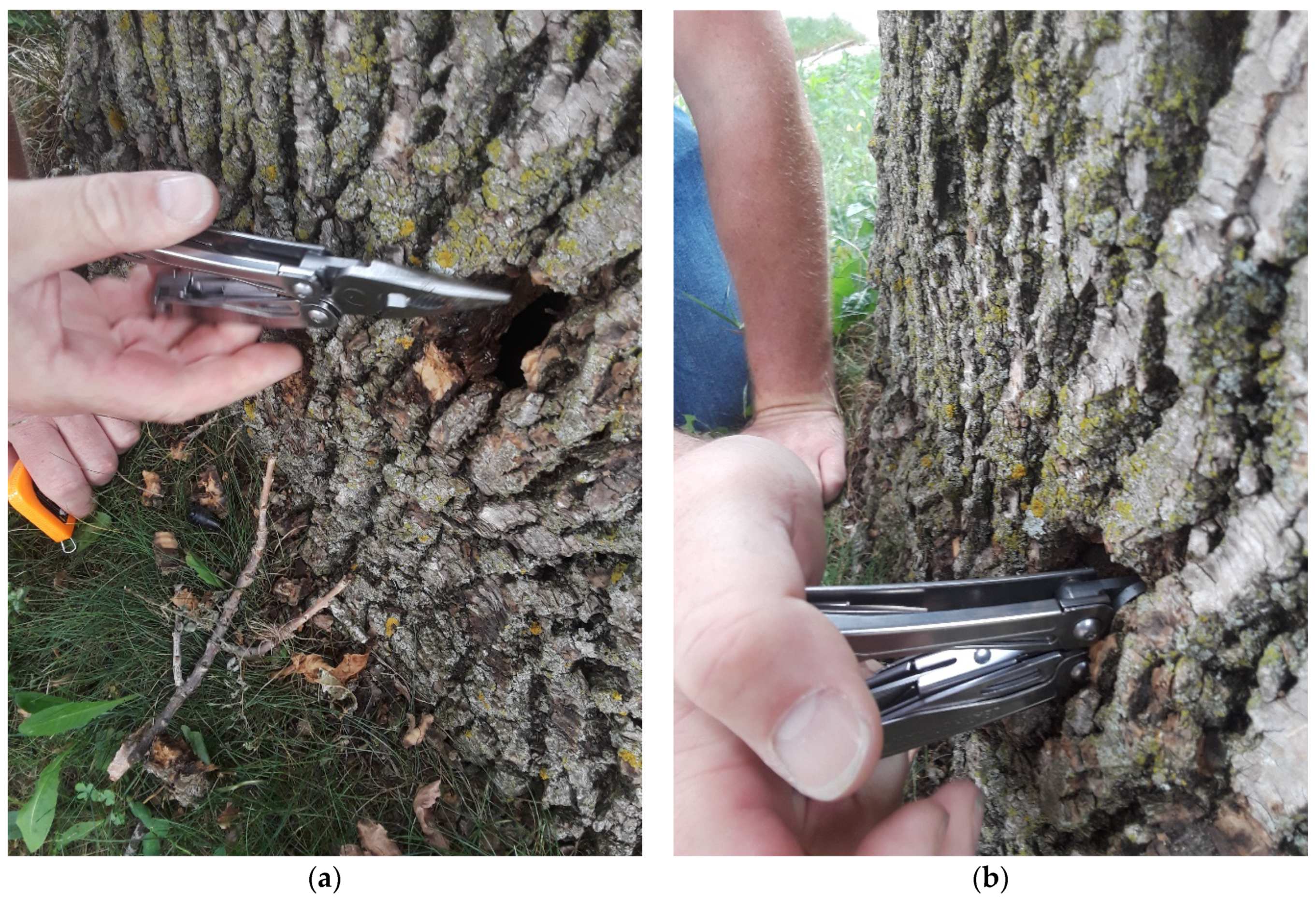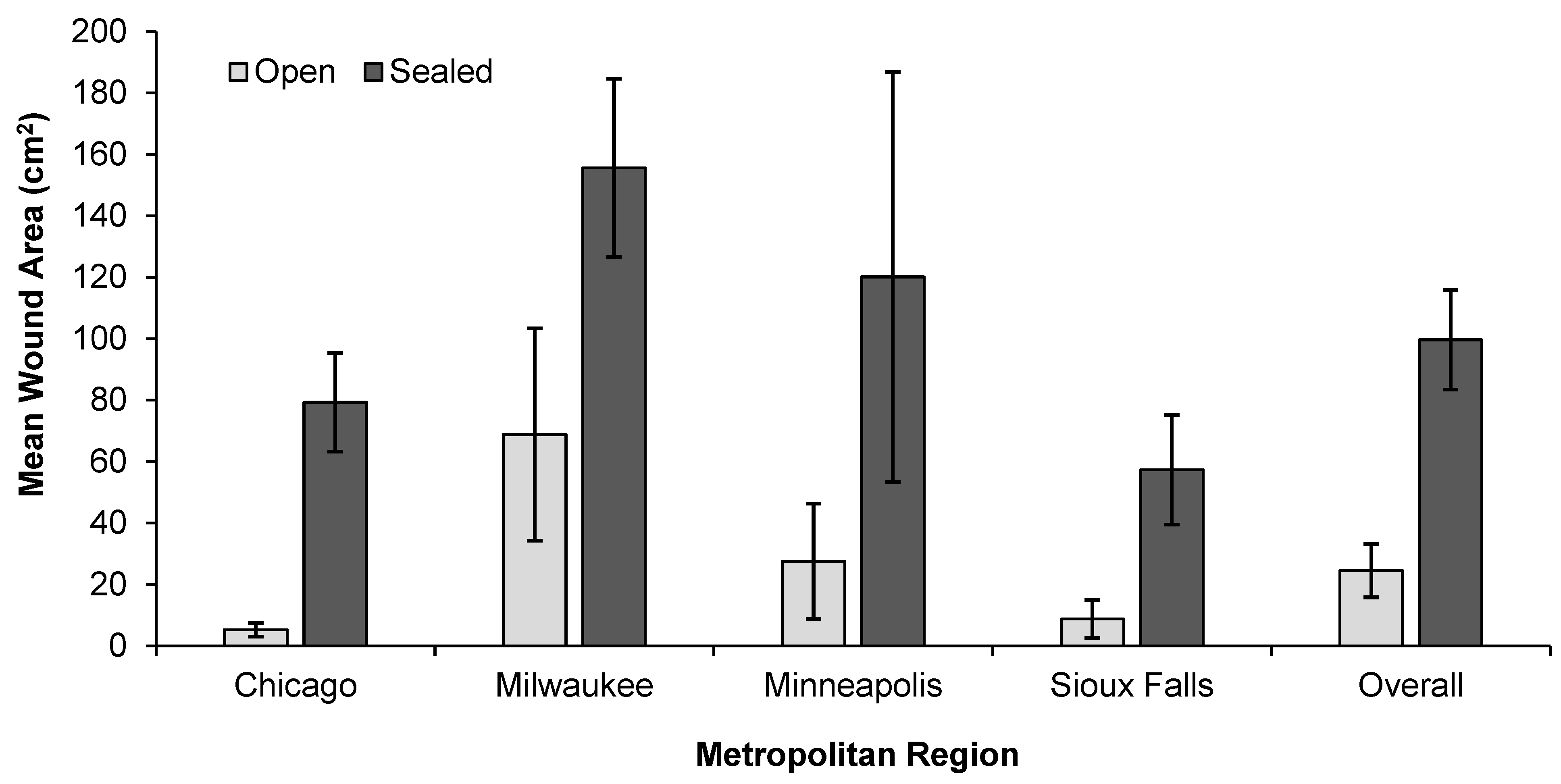Observation of External Wounding on Green Ash (Fraxinus pennsylvanica Marshall) Trees Associated with Tree Injection Systems
Abstract
:1. Introduction
2. Materials and Methods
2.1. Study Species and Locations
2.2. Subject Selection and Data Collection
2.3. Statistical Approach
3. Results
3.1. Treatment System and Wound Size
3.2. Association of Trunk Diameter, Region, and Treatment System with Wounds
3.3. Relationship of Treatment System and Proper Application on Wounds
4. Discussion
4.1. Implications of Findings
4.2. Limitations
5. Conclusions
Author Contributions
Funding
Data Availability Statement
Acknowledgments
Conflicts of Interest
Appendix A





References
- Cappaert, D.; McCullough, D.G.; Poland, T.M.; Siegert, N.W. Emerald ash borer in North America: A research and regulatory challenge. Am. Entomol. 2005, 51, 152–165. [Google Scholar] [CrossRef] [Green Version]
- Herms, D.A.; McCullough, D.G. Emerald ash borer invasion of North America: History, biology, ecology, impacts, and management. Annu. Rev. Entomol. 2014, 59, 13–30. [Google Scholar] [CrossRef] [PubMed] [Green Version]
- Bick, E.N.; Forbes, N.J.; Haugen, C.; Jones, G.; Bernick, S.; Miller, F. Seven-year evaluation of insecticide tools for emerald ash borer in Fraxinus pennsylvanica (Lamiales: Oleaceae) Trees. J. Econ. Entomol. 2018, 111, 732–740. [Google Scholar] [CrossRef] [PubMed] [Green Version]
- Miller, F.; Mueller, D. Protection of ash trees under extended emerald ash borer pressure. Great Lakes Entomol. 2020, 53, 1–24. [Google Scholar]
- Kovacs, K.F.; Haight, R.G.; McCullough, D.G.; Mercader, R.J.; Siegert, N.W.; Liebhold, A.M. Cost of potential emerald ash borer damage in us communities 2009–2019. Ecol. Econ. 2010, 69, 569–578. [Google Scholar] [CrossRef]
- Hauer, R.J.; Peterson, W. Effects of emerald ash borer on municipal forestry budgets. Landsc. Urban Plan. 2017, 157, 98–105. [Google Scholar] [CrossRef] [Green Version]
- Sadof, C.; Hughes, G.; Witte, A.; Peterson, D.; Ginzel, M. Tools for staging and managing emerald ash borer in the urban forest. Arboric. Urban For. 2017, 43, 15–26. [Google Scholar] [CrossRef]
- Hauer, R.J.; Hanou, I.S.; Sivyer, D. Planning for active management of future invasive pests affecting urban forests: The ecological and economic effects of varying Dutch elm disease management practices for street trees in Milwaukee, WI USA. Urban Ecosyst. 2020, 23, 1005–1022. [Google Scholar] [CrossRef]
- Herms, D.A.; McCullough, D.G.; Clifford, C.S.; Smitley, D.R.; Miller, F.D.; Cranshaw, W. Insecticide Options for Protecting Ash Trees from Emerald Ash Borer. North Central IPM Center Bulletin, 3rd ed. 2019, p. 16. Available online: http://www.emeraldashborer.info/documents/Multistate_EAB_Insecticide_Fact_Sheet.pdf. (accessed on 30 September 2022).
- Bernick, S.; Smiley, T. Best Management Practices—Tree Injection, 2nd ed.; International Society of Arboriculture: Atlanta, GA, USA, 2022; p. 43. [Google Scholar]
- Smitley, D.; Doccola, J.; Cox, D. Multiple-year protection of ash trees from emerald ash borer with a single trunk injection of Emamectin benzoate and single-year protection with an imidacloprid basal drench. Arboric. Urban For. 2010, 36, 206–211. [Google Scholar] [CrossRef]
- Flower, C.E.; Dalton, J.E.; Knight, K.S.; Brikha, M.; Gonzalez-Meler, M.A. To treat or not to treat: Diminishing effectiveness of emamectin benzoate tree injections in ash trees heavily infested by emerald ash borer. Urban For. Urban Green. 2015, 14, 790–795. [Google Scholar] [CrossRef] [Green Version]
- McCullough, D.G.; Poland, T.M.; Tluczek, A.R.; Anulewicz, A.; Wieferich, J.; Siegert, N.W. Emerald ash borer (Coleoptera: Buprestidae) densities over a 6-yr period on untreated trees and trees treated with systemic insecticides at 1-, 2-, and 3-yr intervals in a central Michigan forest. J. Econ. Entomol. 2019, 112, 201–212. [Google Scholar] [CrossRef] [PubMed]
- Aćimović, S.G.; Cregg, B.M.; Sundin, G.W.; Wise, J.C. Wise. Comparison of drill- and needle-based tree injection technologies in healing of trunk injection ports on apple trees. Urban For. Urban Green. 2016, 19, 151–157. [Google Scholar] [CrossRef] [Green Version]
- Brazee, N.; Marra, R.E. Incidence of internal decay in American elms (Ulmus americana) under regular fungicide injection to manage Dutch elm disease. Arboric. Urban For. 2020, 46, 1–11. [Google Scholar] [CrossRef]
- Smith, K.T.; Lewis, P.A. Potential concerns for tree response from stem injection. In Onken Brad; Reardon, Richard, Comps, Proceedings of the Third Hemlock Woolly Adelgid Conference, Asheville, NC, USA, 1–3 February 2005; FHTET-2005-01; U.S. Department of Agriculture, Forest Service, Forest Health Technology Enterprise Team: Washington, DC, USA, 2005; pp. 173–178. [Google Scholar]
- Shigo, A.L. Compartmentalization: A conceptual framework for understanding how trees grow and defend themselves. Annu. Rev. Phytopathol. 1984, 22, 189–214. [Google Scholar] [CrossRef]
- Shigo, A.L. Compartmentalization of decay in trees. Sci. Am. 1985, 252, 96–103. [Google Scholar] [CrossRef]
- Shigo, A.; Money, W.; Dodds, D. Some internal effects of Mauget tree injections. J. Arboric. 1977, 3, 213–220. [Google Scholar] [CrossRef]
- Schwarze, F.W.M.R.; Engels, J.; Mattheck, C. Host-Fungus Interactions: Development and Prognosis of Wood Decay in the Sapwood. In Fungal Strategies of Wood Decay in Trees; Springer: Berlin, Heidelberg, 2000. [Google Scholar] [CrossRef]
- Morris, H.; Hietala, A.M.; Jansen, S.; Ribera, J.; Rosner, S.; A Salmeia, K.; Schwarze, F.W.M.R. Using the CODIT model to explain secondary metabolites of xylem in defence systems of temperate trees against decay fungi. Ann. Bot. 2020, 125, 701–720. [Google Scholar] [CrossRef] [Green Version]
- Smith, K.T. Wounding compartmentalization, and treatment tradeoffs. J. Arboric. 1988, 14, 226–229. [Google Scholar] [CrossRef]
- Doccola, J.J.; Smitley, D.R.; Davis, T.W.; Aiken, J.J.; Wild, P.M. Tree wound response following systemic insecticide trunk injection treatments in green ash (Fraxinus pennsylvanica Marsh.). Arboric. Urban For. 2011, 37, 6–12. [Google Scholar] [CrossRef]
- Tannis, S.R.; McCullough, D.G. Evaluation of xylem discoloration in ash trees associated with macroinjections of a systemic insecticide. Arboric. Urban For. 2016, 42, 389–399. [Google Scholar] [CrossRef]
- Beck, H.E.; Zimmermann, N.E.; McVicar, T.R.; Vergopolan, N.; Berg, A.; Wood, E.F. Present and future Köppen-Geiger climate classification maps at 1-km resolution. Sci. Data 2018, 5, 180214. [Google Scholar] [CrossRef] [PubMed] [Green Version]
- Brokaw, N.; Tompson, J. The H for DBH. For. Ecol. Manag. 2000, 129, 89–91. [Google Scholar] [CrossRef]
- Magarik, Y.A.S.; Roman, L.A.; Henning, J.G. How should we measure the DBH of multi-stemmed urban trees? Urban For. Urban Green. 2020, 47, 126481. [Google Scholar] [CrossRef]
- CTLA. Guide for Plant Appraisal, 9th ed.; Council of Tree and Landscape Appraisers International Society of Arboriculture: Champaign, IL, USA, 2000; p. 143. [Google Scholar]
- Hauer, R.J.; Koeser, A.K.; Parbs, S.; Kringer, J.; Krouse, R.; Ottman, K.; Miller, R.W.; Sivyer, D.; Timilsina, N.; Werner, L.P. Long-term effects of a tree preservation program on tree survival, condition, and growth in Milwaukee, WI, USA. Landsc. Urban Plan. 2020, 193, 103670. [Google Scholar] [CrossRef]
- Smitley, D.; Davis, T.; Rebek, E. Progression of ash canopy thinning and dieback outward from the initial infestation of emerald ash borer (Coleoptera: Buprestidae) in southeastern Michigan. J. Econ. Entomol. 2008, 101, 1643–1650. [Google Scholar] [CrossRef] [PubMed]
- Luley, C.J.; Ellison, M. Do you hear what I hear? Part II: Field application of sounding. Arborist News 2018, 27, 40–44. [Google Scholar]
- IBM Corp. IBM SPSS Statistics for Windows; IBM Corp: Armonk, NY, USA, 2021; Version 28.0. [Google Scholar]
- R Core Team. R: A Language and Environment for Statistical Computing. R Version 4.0.0 (2020-04-24). 2021. Available online: https://www.R-project.org/ (accessed on 30 September 2022).
- Montecchio, L.A. Venturi effect can help cure our trees. J. Vis. Exp. 2013, e51199. [Google Scholar] [CrossRef] [Green Version]
- Roach, W.A. Plant injection as a physiological method. Annu. Bot. 1939, 3, 155–226. [Google Scholar] [CrossRef]
- May, C. Methods of tree injection. Trees Mag. 1941, 4, 7, 10–12, 14, 16. [Google Scholar]
- Perry, T.; Santamour, F.S., Jr.; Stipes, R.J.; Shear, T.; Shigo, A. Exploring alternatives to tree injection. J. Arboric. 1991, 17, 217–226. [Google Scholar] [CrossRef]
- Mayhead, G.J. Observations on the use of a high pressure tree injection system. Arboric. J. 1991, 15, 19–26. [Google Scholar] [CrossRef]
- Himelich, E.B. Pressure injection of chemicals into trees. Arborist’s News 1972, 37, 97–105. [Google Scholar]
- Fettig, C.J.; Munson, A.S.; Grosman, D.M.; Bush, P.B. Evaluations of emamectin benzoate and propiconazole for protecting individual Pinus contorta from mortality attributed to colonization by Dendroctonus ponderosae and associated fungi. Pest Manag. Sci. 2014, 70, 771–778. [Google Scholar] [CrossRef] [PubMed]
- Grosman, D.M.; Fettig, C.J.; Jorgensen, C.L.; Munson, A.S. Effectiveness of two systemic insecticides for protecting western conifers from mortality due to bark beetle attack. West. J. Appl. For. 2010, 25, 181–185. [Google Scholar] [CrossRef]

| Variable | Definition | Measurement (Unit) |
|---|---|---|
| Dependent Variables | ||
| Wound Observed | Presence of an external wound detected visually or by sounding as bark cracking and/or exposed wood from ground to 1.37 m | Category (No or Yes) |
| Wound Number | Number of external wounds detected visually or by sounding as bark cracking and/or exposed wood from ground to 1.37 m | Continuous (Count) |
| Wound Area | Exposed external wood area detected visually or by sounding as bark cracking and/or exposed wood from ground to 1.37 m | Continuous (cm2) |
| Independent Variables | ||
| Metropolitan Region | Tree was located in Chicago (1), Milwaukee (2), Minneapolis (3), or Sioux Falls (4) region | Category (1, 2, 3, or 4) |
| Trunk Diameter | Diameter of trunk measured at 1.37 m above the ground (0.1 in precision, converted to cm) | Continuous (cm2) |
| Tree Condition | Measure of tree health from 0 (dead) to 100 (excellent) in 5% increments | Ratio (Percent) |
| Tree Canopy Thinning | Measure of tree health from 0 (no thinning) to 100 (complete thinning) in 5% increments | Ratio (Percent) |
| Treatment System | Tree injection system for drilled hole as either open (no plug, 0) or sealed (plug, 1) | Category (0 or 1) |
| Treatment Location | Treatment locations determined at the Root Stem Transition Zone only (0), Trunk only (1), or Both (2) | Category (0, 1, or 2) |
| Wound Height | Distance above the ground to the base of the wound (measured to nearest in, converted to cm) | Continuous (cm) |
| Wound Cause | Wound was determined associated with treatment (1), something else (2), or unidentified (3) | Category (1, 2, or 3) |
| Treatment Application | Correct application of treatment systems associated with a wound was visually determined | Category (No or Yes) |
| Variable (Unit) 1 | Treatment System | n-Size | Mean | Standard Deviation | Standard Error |
|---|---|---|---|---|---|
| Stem Diameter (cm) | Open | 190 | 48.19 | 14.35 | 1.04 |
| U = 14081, z = −2.526, p = 0.012 | Sealed | 175 | 53.29 | 18.06 | 1.37 |
| Tree Canopy Thinning (%) | Open | 188 | 15.37 | 13.92 | 1.02 |
| U = 15134, z = −1.152, p = 0.249 | Sealed | 173 | 16.39 | 20.76 | 1.58 |
| Tree Condition (%) | Open | 188 | 90.11 | 9.74 | 0.71 |
| U = 14715, z = −1.504, p = 0.133 | Sealed | 172 | 80.15 | 28.68 | 2.19 |
| Wound Number (#) | Open | 190 | 0.17 | 0.52 | 0.04 |
| U = 10385, z = −7.773, p < 0.001 | Sealed | 175 | 1.14 | 1.66 | 0.13 |
| Wound Total Area (cm2) | Open | 190 | 24.54 | 120.32 | 8.73 |
| U = 10590, z = −7.499, p < 0.001 | Sealed | 175 | 99.66 | 214.21 | 16.19 |
| Wound Height (cm) | Open | 22 | 7.79 | 7.40 | 1.58 |
| U = 894, z = −0.146, p = 0.884 | Sealed | 83 | 9.84 | 11.93 | 1.31 |
| Factor | Coefficient | Standard Error | p-Value | Odds-Ratio |
|---|---|---|---|---|
| Intercept | −5.020440 | 0.617254 | 4.17 × 10−16 | 0.006602 |
| Trunk Diameter (cm) | 0.050299 | 0.008812 | 1.15 × 10−8 | 1.051585 |
| Milwaukee | 0.958181 | 0.371155 | 0.00983 | 2.606949 |
| Minneapolis | −0.60348 | 0.422210 | 0.15291 | 0.546904 |
| Sioux Falls | 0.646750 | 0.382573 | 0.09093 | 1.909325 |
| Treatment System 1 | 1.979802 | 0.302269 | 5.76 × 10−11 | 7.241311 |
| Factor | Coefficient | Standard Error | t-Test | p-Value |
|---|---|---|---|---|
| Intercept | −0.0952 | 0.6995 | −0.136 | 0.8920 |
| Trunk Diameter (cm) | 0.0215 | 0.0091 | 2.357 | 0.0204 |
| Milwaukee | 0.8001 | 0.3455 | 2.316 | 0.0226 |
| Minneapolis | −0.5507 | 0.4756 | −1.158 | 0.2497 |
| Sioux Falls | 0.1844 | 0.4258 | 0.433 | 0.6658 |
| Treatment System 2 | 0.9497 | 0.3425 | 2.773 | 0.0066 |
| System (n) | No (%) | Yes (%) | Total (%) |
|---|---|---|---|
| Open (190) | 88.4 | 11.6 | 100.0 |
| Sealed (175) | 52.6 | 47.4 | 100.0 |
| Overall (365) | 71.2 | 28.8 | 100.0 |
Publisher’s Note: MDPI stays neutral with regard to jurisdictional claims in published maps and institutional affiliations. |
© 2022 by the authors. Licensee MDPI, Basel, Switzerland. This article is an open access article distributed under the terms and conditions of the Creative Commons Attribution (CC BY) license (https://creativecommons.org/licenses/by/4.0/).
Share and Cite
Hauer, R.J.; Ball, J.J.; North, E. Observation of External Wounding on Green Ash (Fraxinus pennsylvanica Marshall) Trees Associated with Tree Injection Systems. Forests 2022, 13, 1802. https://doi.org/10.3390/f13111802
Hauer RJ, Ball JJ, North E. Observation of External Wounding on Green Ash (Fraxinus pennsylvanica Marshall) Trees Associated with Tree Injection Systems. Forests. 2022; 13(11):1802. https://doi.org/10.3390/f13111802
Chicago/Turabian StyleHauer, Richard J., John J. Ball, and Eric North. 2022. "Observation of External Wounding on Green Ash (Fraxinus pennsylvanica Marshall) Trees Associated with Tree Injection Systems" Forests 13, no. 11: 1802. https://doi.org/10.3390/f13111802
APA StyleHauer, R. J., Ball, J. J., & North, E. (2022). Observation of External Wounding on Green Ash (Fraxinus pennsylvanica Marshall) Trees Associated with Tree Injection Systems. Forests, 13(11), 1802. https://doi.org/10.3390/f13111802







